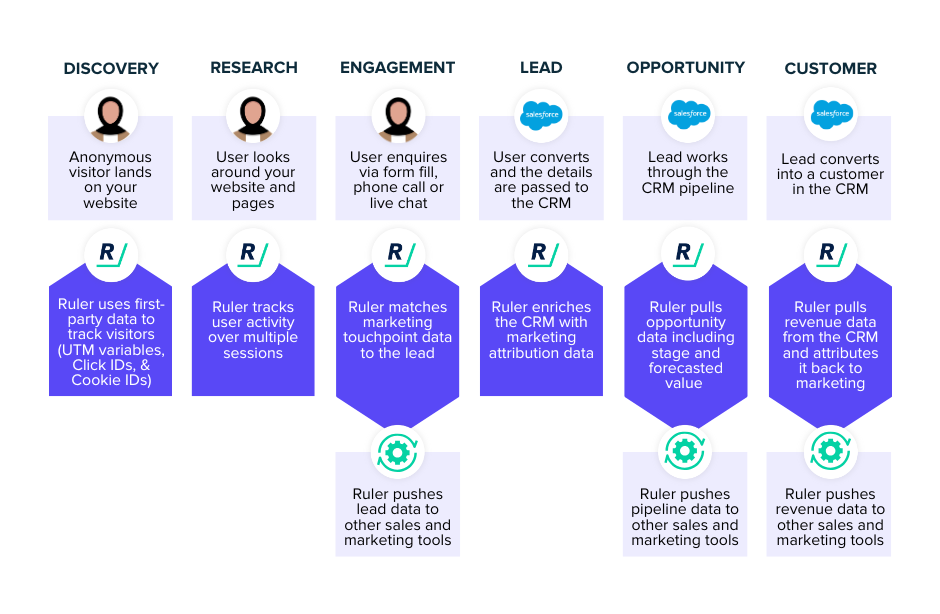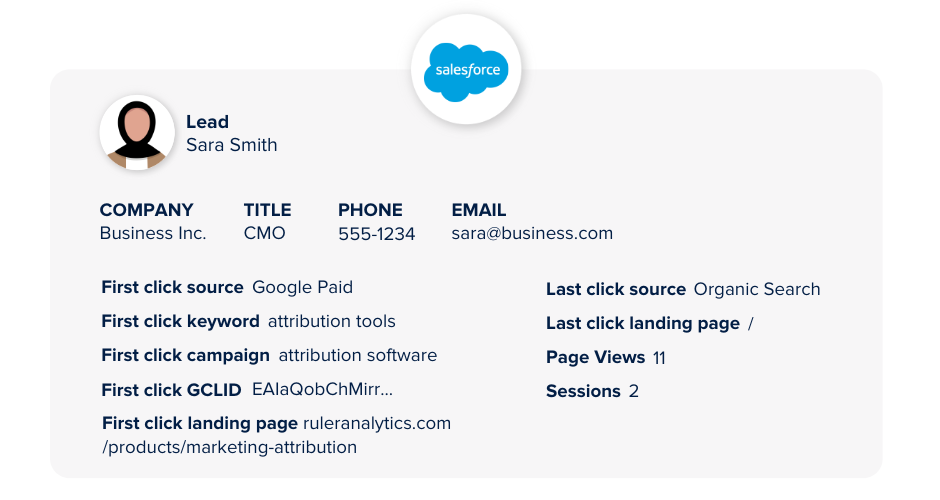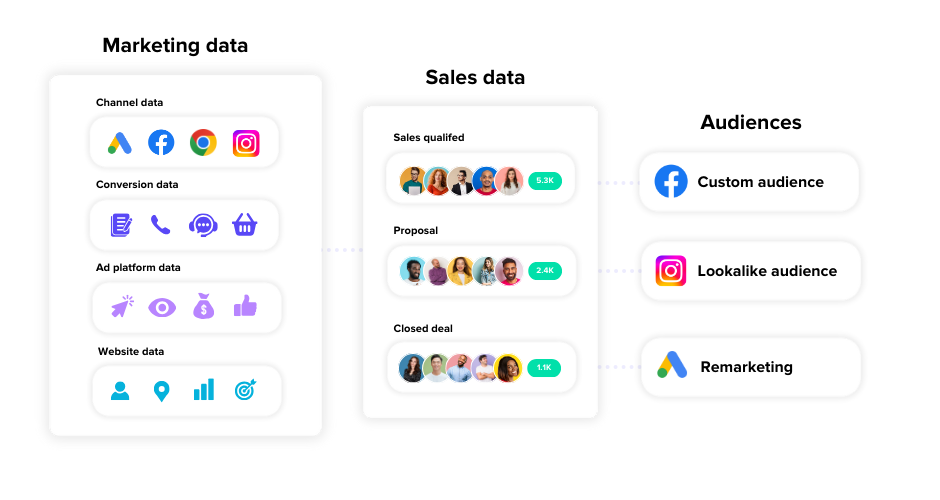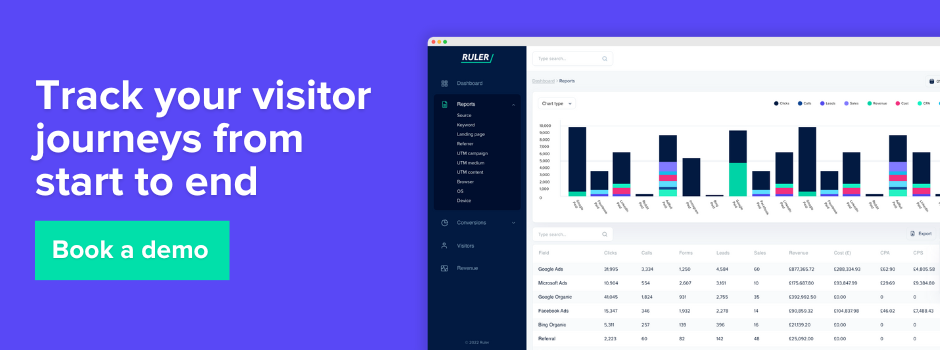Uncover how user interactions and touchpoints drive business outcomes with customer journey analytics.
Customer journeys are increasingly complex and extended, often spanning months across multiple channels.
With privacy updates from Apple and the demise of third-party cookies, tracking performance – especially for paid campaigns – has become more challenging.
In this blog post, we explore how customer journey analytics can provide the visibility you need to better understand your audience and make informed decisions on where to allocate your budget.
💡 Pro Tip
Ruler tracks the entire customer journey from first-click to closed deal. Using first-party tracking tags, we monitor page views, traffic sources, UTM parameters, and conversions to reveal how individual users interact with your site. This data provides valuable insights into how these interactions drive outcomes like opportunities, deals, and revenue. Plus, it integrates cost data, allowing you to measure ROAS and ROI accurately – without relying on biased in-platform reporting.
Book a demo to see how Ruler integrates everything seamlessly
Understanding how customers interact with your brand is essential to improving their experience and driving better business outcomes.
Customer journey analytics is the process of analyzing every interaction a customer has with your brand across multiple touchpoints – from the first ad they see to the moment they make a purchase or leave your website.
It provides a complete picture of the customer experience by connecting data across channels, platforms, and devices.
To carry out this analysis, businesses often use tools like Google Analytics, Ruler Analytics, or other attribution platforms.
These tools help track customer behavior in real time and allow marketers to understand how users move through the journey.
By accessing and analysing this data, brands can gain a bird’s-eye view of the entire customer journey. This visibility enables them to see what touchpoints are driving conversions and which ones are underperforming.
Just as importantly, it helps identify bottlenecks – moments where the customer might drop off, lose interest, or encounter a barrier. With these insights, brands can make informed decisions about where to optimize, ensuring the journey is as smooth and effective as possible for their customers.
While they are closely related, customer journey mapping and customer journey analytics serve distinct purposes in understanding the customer experience.
Customer journey mapping is the process of visually outlining the steps a customer takes when interacting with a brand.
It typically includes stages such as awareness, consideration, purchase, and post-purchase engagement. These maps help teams conceptualise the customer’s path and identify key touchpoints along the way.
Customer journey analytics, on the other hand, moves beyond visualization to focus on measurable data.
It involves collecting and analysing real-time behavioral data from actual customer journeys.
This analysis allows businesses to uncover patterns, evaluate the effectiveness of each touchpoint, and gain evidence-based insights into customer behavior.
Together, these tools create a powerful framework.
Journey maps provide a strategic overview, helping teams align on the ideal customer path. Journey analytics brings that map to life, confirming what’s actually happening and revealing areas that need improvement.
Google Analytics is one of the most accessible analytics tools available.
It’s widely used across industries, but when it comes to tracking the full customer journey, it has some notable limitations.
One of the primary challenges is that much of the data in GA4 is aggregated. This means you can’t easily trace the actions of a specific user – where they came from, what pages they visited, or what actions they completed on your website.
You get broad insights, but the detailed, user-level tracking that many marketers need is harder to come by.
That said, if your website or application includes a login system, you can use GA4’s User ID feature. When someone lands on your site, GA4 sets a cookie and assigns an anonymous, unique ID to that user.
However, there are some important caveats.
First, the User ID feature only works when users log in.
Through the User Explorer report, you can see various interactions such as page views, events, purchases, or goal completions linked to that anonymous ID.
Not every visitor to your website will authenticate themselves, and without that login, GA4 can’t assign or recognise a unique User ID. The ID must be passed from your authentication system, so unless the user signs in, this feature won’t be of much use.
Second, GA4 doesn’t allow personally identifiable information (PII) to be sent through its system. This includes data like names, email addresses, and phone numbers.

While this is critical for privacy compliance, it creates a major disconnect for marketers trying to link website behavior with known customer records.
Instead, GA4 only provides alphanumeric IDs that are not directly tied to a real person.
Lastly, Google made significant changes to its attribution tracking in GA4 in recent years. It now supports only two models – last-click and data-driven attribution.
The problem with last-click attribution is that it fails to reflect the often non-linear, multi-touch journeys users take before converting.
Data-driven attribution aims to solve this by using machine learning, but it lacks transparency. Google does not disclose how its model works or what signals it uses, which has led to growing skepticism within the analytics community.
All of this makes GA4 less than ideal for marketers who want a clear, end-to-end view of the customer journey.
While it still offers valuable insights, those looking for more granular, people-centric tracking often need to look beyond Google Analytics for more tailored solutions.
The good news is that you’re not limited to Google Analytics 4 when it comes to understanding how customers move through your funnel.
There are more efficient and flexible ways to track the customer journey, and it all starts with a structured approach. Below are five key steps to help you get started.
💡 Pro Tip
Tracking the customer journey through analytics helps you identify which pages or paths drive profitable outcomes. But not every journey involves a click. Upper funnel campaigns on platforms like TikTok and Instagram often influence users through impressions, shaping decisions that lead to conversions later through direct visits or organic search. That’s why it’s important to use methods like incrementality testing and marketing mix modeling for a complete view. We’ve documented every step in our marketing measurement framework to guide you.
Take a look at our framework to see how it all connects
Before diving into any tracking setup, it’s essential to get clear on what you actually want to measure, and why.
Think about the business questions you’re trying to answer.
Are you aiming to understand how users convert from a paid ad campaign? Are you looking to see how your email marketing influences purchases over time?
Or are you trying to map the entire customer journey from the first touchpoint through to loyalty and repeat engagement?
Setting clear goals and objectives ensures you’re not just collecting data for the sake of it – you’re gathering insights that directly support your decision-making. This step acts as a compass for the entire analytics process.
Without it, you risk focusing on vanity metrics that don’t tie back to outcomes that matter.
To recap, the core challenge with Google Analytics is its reliance on aggregated data and the lack of personally identifiable tracking.
This makes it difficult to understand individual customer journeys in detail. First-party data is essential for accurate and actionable customer journey analytics.
To achieve this, you need tracking systems that capture user interactions directly on your website or app, ideally tied to a unique identifier.
Ruler is a good example. Its first-party tracking tags collect detailed data across multiple touchpoints, including page views, traffic sources, UTM parameters, and conversion events.

When these events are linked to identifiers such as an email address or phone number, they provide a clear, granular view of how users interact with your brand.
This enables precise attribution of key actions – whether it’s a form submission, live chat, phone call, or purchase – to the appropriate marketing channel.
With privacy regulations tightening and browser policies limiting third-party tracking, first-party tracking is no longer optional. It’s now a critical component of effective marketing measurement.
Another limitation of GA4 is that it doesn’t track later-stage outcomes like opportunities, deals, or revenue.
Customer journeys don’t stop at a click or a form submission – yet marketers relying solely on tools like GA are often optimising based on lead volume alone.
The problem is, not all leads are equal. Different channels drive different types of leads, with varying levels of quality and revenue potential.
To truly understand what’s working, you need to connect early-stage behaviors – like ad clicks and website visits – to meaningful outcomes such as purchases, subscriptions, or closed deals.
This typically requires integrating your first-party tracking with tools like your CRM, payment platform, or internal databases.

Platforms like Ruler help automate this process. They enrich leads with marketing source data at the point of conversion and carry that data through the entire funnel.
This gives you visibility into which efforts are driving your most valuable leads – so you can double down on what actually delivers revenue, not just volume.
To truly measure the effectiveness of each marketing touchpoint and channel, you need a clear view of what you’re spending.
That means incorporating media costs from platforms like Google Ads, Meta, LinkedIn, and others directly into your measurement.
The challenge with relying solely on ad platform reporting is that it’s inherently biased.
Every platform wants to take credit for conversions, often leading to duplicated attribution and inflated ROAS or ROI figures, making it difficult for marketers to confidently decide where to invest next.
By integrating your cost data alongside the customer journey insights you’ve captured through first-party tracking, you gain a more accurate and independent view of performance.
This lets you move beyond siloed platform reports and calculate blended metrics like true CPA and ROAS.
With this clarity, you can identify which channels are actually driving results, and make smarter decisions about where to scale or cut back.
Once you have visibility over individual journeys, post-conversion data, costs, and how it all works together, what comes next?
Beyond reporting to leadership and using the data to demonstrate that your efforts are making a difference, it’s time to put that data to work and create an even bigger impact.
The advantage of using a first-party data platform, capturing IDs, and linking that data with CRM stages is the ability to automate data transfers to your ad platforms for better targeting.
Rather than relying on basic retargeting campaigns that show ads to people who’ve just visited your website – often a waste of money, as you might end up showing them to existing customers – you can build more refined audiences.

For instance, if a lead reaches a certain stage in your pipeline, you could automatically send that data to Meta to serve ads encouraging them to progress to the next stage.
Customer journey analytics is no longer just a nice-to-have – it’s an essential tool for understanding your customers, optimising marketing strategies, and driving better business results.
By setting clear goals, tracking first-party data, connecting your efforts to measurable outcomes, and integrating ad spend insights, you can achieve a comprehensive, unbiased view of the entire customer journey.
Curious to see how first-party tracking works in action?
Book a demo with us, and we’ll walk you through how Ruler can give you greater visibility into the customer journey, seamlessly link with your CRM to track post-conversion actions, and integrate with your cost data to provide a more accurate picture of performance.
